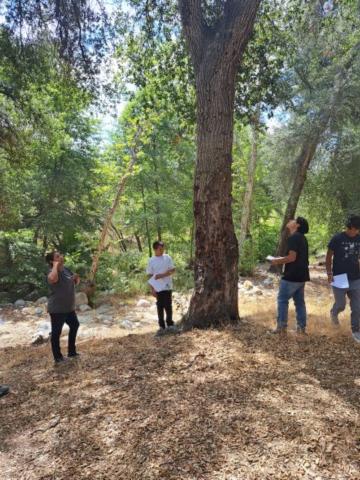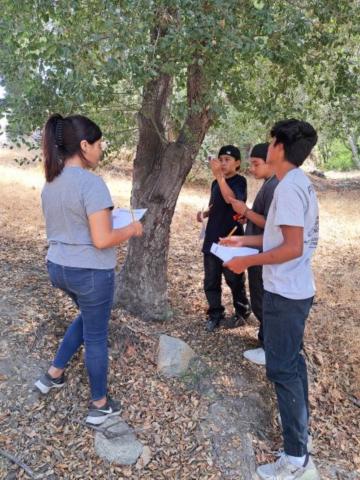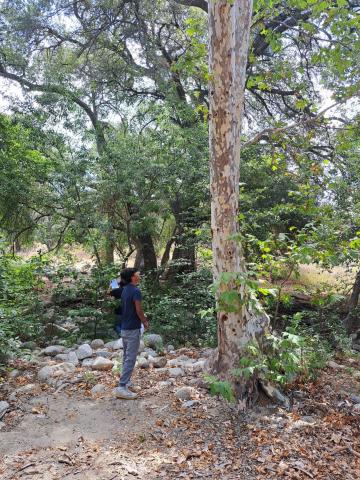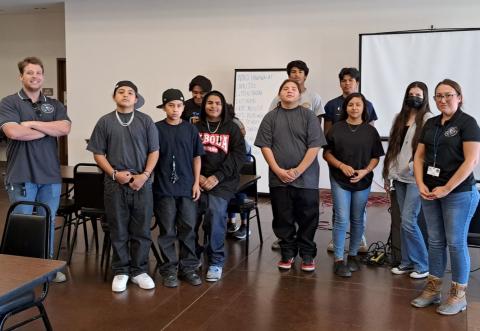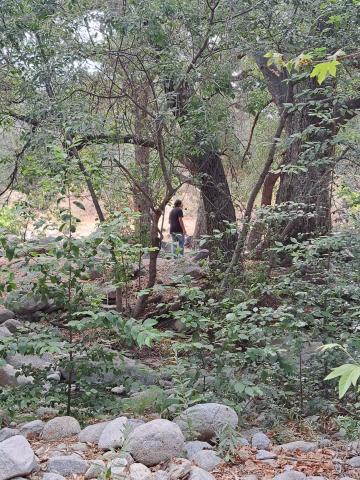As part of Soboba’s annual six-week Summer Youth Academy, about 15 participants aged 13 to 17 explored community awareness and service with the help of the Soboba Tribal Environmental Department. On July 14, Environmental Specialist Micah Knox and Administrative Assistant Angelica Rangel spent the day educating youths with a hands-on lesson at Indian Creek and the presentation of a documentary about the effects of climate change.
The students learned about the oak trees that grow on the Soboba Indian Reservation. Conducting a mock tree tagging exercise, the students were asked to note the size, canopy health, insect and fungus presence, injury presence and nearby saplings for six trees. Knox said the exercise was designed to highlight the importance of tree health on and off reservation.
“I think the overall idea was to help the students understand that things in nature are not as temporary as we are,” Knox said. “People go around destroying their natural habitat and taking it for granted. In reality, these oaks and all other natural habitats will live on well after we leave. With this, we need to learn to treat nature with kindness and respect.”
By definition, tagging a tree is nailing a number tag for the purpose of research. In this way a database can be created of the oaks on the reservation that will identify their canopy cover, crown rating, insect emergence, external damage and other factors.
Knox said there are well over 1,000 oaks growing on the Soboba Indian Reservation and only 136 are actually tagged and accounted for. Of the current amount, he said about 80% of them have health issues, big or small. Of those 80%, he feels about 95% of them are salvageable.
He said that thankfully there are no signs of the Goldspotted Oak Borer, a buprestid beetle which is native to oak forests of Southeastern Arizona, or Sudden Oak Death tree disease anywhere on the property.
“It’s up to the natural ecosystem and human intervention to make sure our oaks are happy and healthy,” Knox said.
He believes that hands-on learning is by far the best way to go about teaching kids, especially if that topic is hands on to begin with.
“I know I wouldn’t want to learn about tree tagging from a Powerpoint; I want to learn about it out there in the wilderness!” Knox said.
After the field experiment and a hearty lunch, students viewed the documentary “Before the Flood,” which goes into depth on the effects of climate change, large corporations’ hand in environmental degradation and what we as a planet are doing to stop this despite pushback from billion-dollar corporations. The students were given questionnaires to complete alongside the documentary to help them fully understand the information presented.
National Geographic’s “Before the Flood” features Leonardo DiCaprio on a journey as a United Nations Messenger of Peace, traveling to five continents and the Arctic to witness climate change firsthand. For more information, www.beforetheflood.com.
“This documentary is by far the most recent and relatable to a younger crowd of high school age students and I believe one of the most important pieces of media of our generation,” Knox said. “It all ties into the message conveyed with the oak trees: we are destroying something that came before us and will be here after us. We need to take a moment and think before we continue our actions.”
The key points he wanted the students to take away from watching the film were understanding that big shell companies are partly to blame for climate change, as well as agriculture; to understand the significance of the Paris Agreement (Paris Climate Accord); and to understand the severity of their actions and what the future holds if we continue doing the things we are doing. For more information, https://unfccc.int/process-and-meetings/the-paris-agreement/the-paris-ag....
One fairly easy thing people can do to lower their carbon footprint is to eliminate beef from their diet since cows take up 40% more land than a chicken and are one of the leading producers of methane on the planet.
Another significant fact that was communicated in the film was the fact that if the world becomes four degrees warmer, we could see coastal communities underwater and mass migration inland causing drought, famine, disease and infrastructure issues. The ice caps could fully disappear, Greenland’s country size would diminish significantly and many ice dwelling mammals would go extinct. There is also the idea that fish migration associated with temperature change could see our countries experiencing border wars over who has rights to the fish as they move closer to the poles.
“The movie suggests lowering your carbon footprint by any means necessary, educate yourself on alternative energies and be mindful of our planet,” Knox said.
He said creating an all-day lesson plan that meets the interest level of all students is not difficult as long as the concept is relatable and exciting to a wide range of people.
“I’m 24 and I enjoy the topic as much as someone a decade younger than me,” Knox said.
Other areas of focus during this year’s Summer Youth Academy included team building, culture, STEM, health and fitness and leadership. Most also attended the National UNITY youth leadership conference in Minneapolis, July 7-12. With a theme of “Restoring the Spirit of Native Youth” many guest speakers provided information and activities about ways to maintain strong spiritual, social, mental and physical health.
Photos courtesy of the Soboba Band of Luiseño Indians


